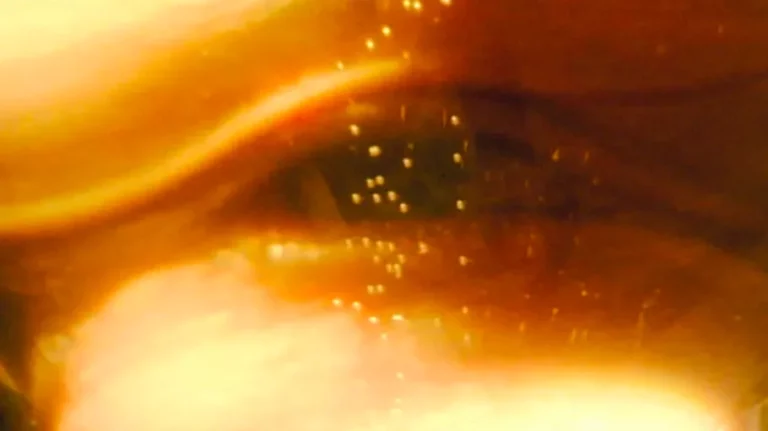Olga Chernykh’s adventurous IDFA opener mixes diaristic, poetical and archival elements to convey life in a war zone, past and present.
War onscreen, whether fictive or documentary, is often a sort of highlight reel: the excitement and terror of battle, cities in flames, the devastated aftermath. It’s infrequent that a film dedicate itself to the disorientation of civilian survival in a long-term war zone, when everyday life goes on to an extent despite a surreal atmosphere of constant threat, and the uncertainty of any future at all.
That largely interior state is what director Olga Chernykh seeks to capture in “A Picture to Remember,” which opened the 2023 International Documentary Film Festival. Her family having already endured various erasures during the Russian Revolution, World War II and the fall of the Soviet Union, Chernykh catalogs the remaining evidence of their past as Russia’s invasion of Ukraine once again threatens to wipe the slate brutally “clean.”
This arresting short feature, which mixes elements of film diary, experimentalism, reportage and archival assembly, stretches the documentary form in ways that are personal without being self-indulgent. Its intensely first-person take on the experience of war is no less potent for interpolating elements of poetry and nostalgia. That tilt underlines how armed conflict destroys civilian histories even as it writes new chapters for the victors.
Chernykh was raised in Donetsk, mineral-rich Donbas’ industrial center, to a family of high-end medical scientific professionals. She’d already left for the nation’s capital Kyiv, when that region was seized by pro-Russian forces in 2014. Her parents hastily abandoned their roomy home to flee and move into this daughter’s cramped quarters, though grandmother Zorya chose to stay behind.
“Picture” more or less starts on Feb. 24 of last year, when Russian aggression drastically escalated to a full-on invasion that included targeting Kyiv, in the central north. The filmmaker’s first-person narration begins incongruously with “I adore champagne,” though we soon realize the occasion for this not-quite-celebratory imbibing is that she, her mother and another woman have taken shelter from the onslaught in a basement.
That hideaway lies below the city morgue where mother Olena now works as a pathologist. The director had originally intended to make a documentary about her parent’s peculiar job and work environ, footage from which we see here. But needless to say, that thematic focus receded once the immediacy of war overwhelmed all other considerations. Then, she says, “my reality became an endless dream, with erased borders between memories and real life.”
Though explanatory background emerges sporadically during the film’s progress, “Picture” never feels obscure or wayward. Its stream-of-consciousness air provides us with the right intel needed at the right time in Kasia Boniecka’s exceptional editorial assembly. Within the film’s relatively brief 72 minutes, there’s a world of experience, ideas and history covered. We get chilling surveillance footage of the city as shellings begin; TV reportage of the invasion, featuring Chernykh’s news-anchor best friend; black-and-white footage of drone-delivered bomb strikes.
But those and other, more personal elements represent just the present tense. The director also incorporates a wide range of photos, home movies and errata charting her own past, plus that of her family’s last few generations. They’ve been an apparently prosperous clan, often seen on vacation or otherwise at play — though that cheerful appearance hides all buffeting by shifting political winds.
State archival materials contribute an even wider view, including clips from such propaganda films as Dziga Vertov’s 1930 “Symphony of Donbas” (aka “Enthusiasm”). While Chernykh doesn’t look further back than the last century, we absorb the clear message that Ukraine has long been a pawn in other nations’ conflicts and empire-building.
On a more intimate level, she offers as leading characters the matrilineal trifecta of herself, her mother (about whom she seems to have mixed feelings) and the beloved grandma. During one Zoom call, the 80-year-old woman casually notes she’s had to replace all her windows — they shattered during recent military skirmishes.
There are also touches of the abstract, cosmic and poetical, from glimpses of Olena’s laboratory microscope slides to holiday fireworks that fade seamlessly into equally picturesque “rain of fire” from long-distance weaponry. At one point the director ponders the unusual nature of clouds overhead, only to realize they are massed missile trails.
Even more straightforward scenes from everyday life cannot escape a sense of foreboding: Video of her teenage antics in Mariupol are tempered by the thought that that place is now “wiped from the face of the Earth.” Her father’s “hobby” (his dayjob is in a “dull office”) consists of painting striking artworks, including a cyclorama of war and forced migration that recalls Picasso’s “Guernica.” Stray domestic details like a key in a door or a fish tank become totems of civilian fragility, of lives that can be demolished in an instant.
“I see bits of resilience crumbling … it’s time to get out,” Chernykh says toward the end, implying that she too may become a refugee. “A Picture to Remember” constitutes an impressionistic preservation, then, of an individual and collective past that the director knows might soon have any other material evidence evidence of its existence erased. This complex but poignantly accessible collage benefits from the diversity of visual formats utilized, as well as an adventuresome, spectral original score by Maryana Klochko.
![]() Post Views: 1,336
Post Views: 1,336

